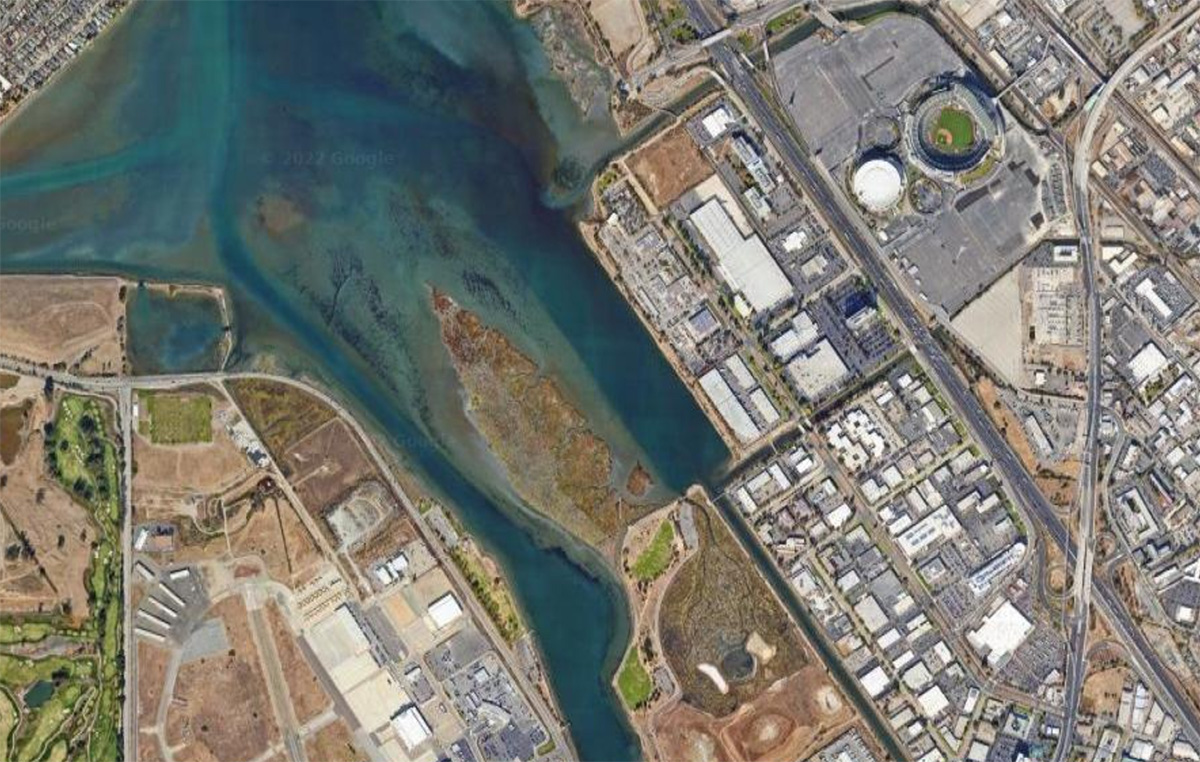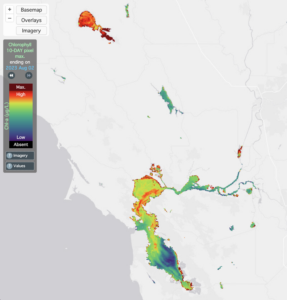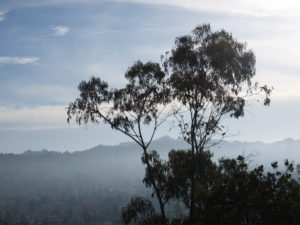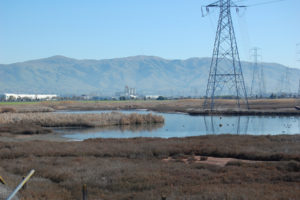If you look up the Arrowhead Marsh along the Oakland shoreline on Google Maps, the arrowhead shape is striking. If you look closer, you see that the eastern half of the marsh is noticeably darker in color than the western half; there seems to be an imaginary line bisecting the marsh, and there might as well be.
In the 1970s, the Army Corps of Engineers introduced a species of Atlantic cordgrass from the East Coast, called Spartina Alterniflora, to the Alameda shoreline. The East Coast Spartina interbred with the native species of Pacific cordgrass, Spartina foliosa, spawning the hybrid Spartina alterniflora x foliosa.
The hybrid species – and its further hybridized forms — reproduced at a much faster rate than the native Spartina foliosa and in the ensuing decades spread across Bay Area marshes, including Arrowhead. As it spread, the non-native Spartina drastically altered tidal marshes to the detriment of the wildlife they support. It grew across once-open mudflats, which are important foraging habitat for shorebirds. It edged out Spartina foliosa and other native plants like pickleweed, which are crucial for the endangered salt marsh harvest mouse.
In 2000, the California State Coastal Conservancy, the East Bay Regional Park District, and the United States Fish and Wildlife Service founded the Invasive Spartina Project (ISP) to systematically eradicate the hybrid Spartina from wetlands in the Bay Area. Over the last 20 years their efforts have helped reduce the spread of the hybrid Spartina significantly in the Bay Area’s 70,000 acres of tidal wetlands. At a cost of $45 million, the area covered by hybrid spartina has shrunk from 805 acres to 38 acres. But as they worked, they found a catch that has prevented them from eliminating it completely.
As the Spartina receded, the population of Ridgway’s rails — a species protected by the Endangered Species Act — dwindled as well, because the hybrid Spartina was a more favorable nesting site for them than the native Spartina. To maintain the population of rails in the Bay Area, the ISP held off on complete eradication of the hybrid Spartina in some marshes like the Arrowhead Marsh, where the prevalence of rails was especially high.
“The hybrid Spartina was eradicated from one half of the marsh, but it was allowed to persist in the other half, because eliminating it completely would severely impact the Ridgway’s rails,” said Doug Bell, a wildlife program manager with the EBRPD.
For now, the ISP clears as much hybrid Spartina as possible from the treated half of the marsh every summer. The marsh, like many other Bay marshes, exists in a state Bell described as a “dynamic equilibrium,” its careful management visible as lines on a satellite map.

Now that it’s clear the hybrid can’t be fully eradicated, though, UC Berkeley associate professor Kristina Hill says she thinks it should be embraced. Hill, a sea level rise and coastal adaptation expert who’s part of a Bay restoration group created by the city of Alameda, says the Spartina could be a powerful ally against the threat of rising sea levels.
In many Bay Area marshes, restoration teams rely on artificial sediment to ensure sea level rise does not submerge marshes. Hill believes that the fast-growing and dense hybrid Spartina could help keep the surface of Arrowhead Marsh above sea level naturally, and offer protection against flooding. “A vigorous plant like the hybrid Spartina is perfect for the biggest problem we have now, which is sea levels rising faster than the marshes,” she said.
The ISP does not agree, and says it will continue to eradicate hybrid Spartina in all but small, carefully managed habitat areas. In an email, Marilyn Latta, a project manager at the State Coastal Conservancy, cited the many negative impacts of the hybrids on native wetland species as one of the main reasons driving the ISP’s efforts.
Hill counters that the magnitude of the sea level rise problem is such that there’s no time left for a focus on individual species. “Sea level rise is going to create winners and losers of its own in the biological world and alter the mix of species residing in the Bay Area,” she said. Instead, she advocates for the protection of the underlying processes of landscape formation, and in this case, the vigorous vertical growth of the marsh as the desired outcome to combat sea level rise.
Other scientists say Hill understates the threat of the hybrid grass. Peter Baye, a coastal ecologist who was involved with the ISP in its early days, recalled an overwhelming impact of previous waves of invasive hybrids on the Hayward shoreline before the establishment of the ISP.
“I actually saw them marching out into the mudflats and filling up the tidal ponds, colonizing them and capturing creek beds,” he said. “I’m just hoping that we don’t lose that larger, long-term perspective and the memory of what it was like in the early days of the invasion.”

Baye pointed out that hybrids and new species spread at an alarming rate, especially after droughts, when tidal marshes become more saline. With more frequent droughts projected in California’s near future, he thinks all other options must be considered before allowing the hybrid to persist.
“It’s an oversized tool with noxious side effects,” he said. If the cordgrass is allowed to persist, he said, “You will be writing off the future biological diversity of almost all other plant species and most other wildlife species, including the potential of something else.”
Bell agreed, saying that unchecked hybrid Spartina would not only alter tidal marsh ecosystem but also reduce future biological diversity significantly, creating a monoculture. “If we brought back the invasive Spartina, it would be like throwing the baby out with the bathwater,” he said.
Hill says it’s her belief that the disturbance caused by rising sea levels and human intervention to raise the surface of the marsh will keep the hybrid Spartina from colonizing entire marshes and forming monocultures. Instead, she says, she thinks it is likelier that the hybrid Spartina will grow into distinct clumps or patches across the wetlands, an ecological feature called patchiness.
“The idea is that if you’d throw 50 snowballs at the side of a barn, then you get patches of white against the barn door,” she said. “And the idea is that you see these patches [of hybrid Spartina] emerge as a mosaic, and that promotes habitat diversity, which in turn promotes species diversity.”
With most of the work to eliminate the hybrid done, the ISP has been clear that it will not change course now. “The impacts of invasive Spartina are well recognized,” said Latta in an email. “This work is fully permitted, consistent with local, state, and federal environmental protections; and has the support of more than 150 baywide landowning partners, regulatory agencies, natural resource agencies, academic institutions, consultants, and non-profit partners.”
Despite the institutional and scientific support behind the ISP, Hill says it’s a job that will never be complete – because despite the ISP’s efforts, the hybrid spartina will return eventually.
“So the question is, what will they do when it comes back?” she said. “It’s really difficult to keep it out forever.”
The divide between Hill and the ISP and other coastal ecologists illustrates some of the new pressures climate change places on conservation science. In a world that’s already changing rapidly, scientists and conservation organizations increasingly have to navigate multiple, sometimes competing threats, and look for solutions while navigating laws written decades ago on the assumption of a stable climate.

Katharyn Boyer, a professor of biology at San Francisco State University who has worked on Bay restoration for decades, believes that the ship has sailed for the hybrid Spartina – given that the ISP’s efforts have already eradicated it from most of the Bay, it makes no sense to change strategies now, she said. But she advocates for more serious discussion about out-of-the-box alternatives like Hill’s, even ones that don’t conform to conventional ecological practice.
Boyer said she has faced resistance from land management agencies when it comes to interventions that are not historically part of the San Francisco Bay, such as a proposal to deposit coarse sediment at the fringes of eroding marshes to mitigate wind and wave energy, and the introduction of concrete oyster reefs to help create a living shoreline. But for her, the fact that the artificial oyster reef project was greenlit in the end is an indicator that agencies are now more open to “non-natural” interventions.
“I am a big proponent of native species,” Boyer said, “but I do think there is merit in the idea that we do not have to manage for species that have historically been in the Bay, because we have a very different Bay than we did in the past.”
Echoing Boyer, Hill argues that resource managers should change the way they think about wetland restoration in the Bay Area and adapt their strategy to the revised projections of sea level rise.
“When they started restoring wetlands in the 1970s, there was an assumption of a very slow rise in the sea level, and that assumption is out the window now,” she said. “A vigorous Spartina is our friend, thinking about how we are going to raise the surface of our marshes so that they can persist in the next hundred or two hundred years.”




